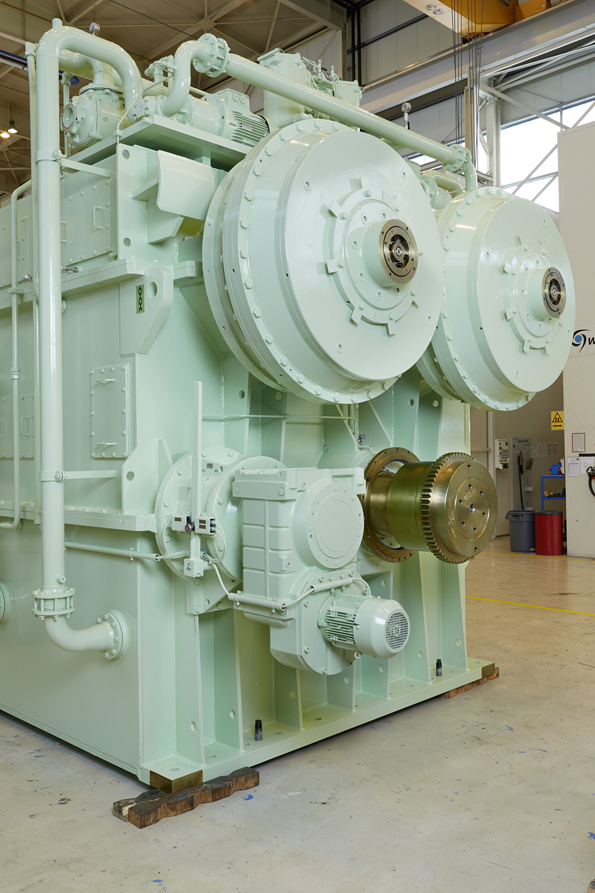World’s biggest trailing suction dredger

The Malaysian shipping company Inai Kiara SDN BHD has unveiled the world’s biggest suction dredger. To allow use in water depths of up to 120 meters and ensure that all the components could be accommodated within the constrained dimensions of the ship’s hull, the shipbuilder opted to use drive technology from Siemens.
Almost 200 meters in length and with a loading capacity of over 30,000 cubic meters, the new Inai Kenanga dredger belonging to the shipping company Inai Kiara SDN BHD is one of the world’s biggest hopper suction dredgers. This type of ship is used for mining raw materials or for deepening and widening waterways.
The dredged material is suctioned off the water bed using two lateral suction pipes and pumped into the hopper. The water contained in the material is separated and returned to the waterway. Using its standard equipment, the hopper suction dredger is able to reach depths of up to 35 meters. With the aid of extended trail pipes and additional pumps, it is capable of reaching depths as great as 120 meters.
Flender gearboxes for maximum output
The Inai Kenanga is fitted with a double engine system which drives the propellers and suction pump systems simultaneously. Two switchable GJZ 2250 type dredger gearboxes from Siemens were used for the main pump.
Because their three switchable gear stages enable the output speed to be adjusted in line with the changing operating conditions of the driven pumps, these Flender gearboxes between the motor and pump allow the pumps to operate at maximum suction output.
As a result, both suction from different depths and discharge of the load can take place using just a single drive. For the discharge process, the pumps can additionally be switched in series. When discharging loads, two jet pumps with electric motors and type G1EE 630 pump gearboxes are optionally also available.
The two large gearboxes, each weighing over 90 tons, are driven by two MAN series 12V48/60 main engines with a total output of 26,500 kilowatts. Type GUCQ 1470 propulsion gearboxes are arranged behind the main engines. These are used for driving the hopper dredger and are designed for a full engine output of 13,250 kilowatts each.
Space-saving complete solution
The challenge inherent in designing the complete drive system was the need to accommodate it in a restricted space. Siemens rose to the challenge by coming up with a highly space-saving design for the gearbox. The layout selected also permits easy maintenance of the hydraulic couplings mounted at the back. «
Siemens Flender Gear Units
www.industry.siemens.com/drives/global/en/gear-units/Pages/Default.aspx
Contact
Siemens AG
Communications and Government Affairs
Internal and External Communications
Gleiwitzer Str. 555
90475 Nuremberg, Germany
Contact MediaService
Ursula Lang
Tel.: +49 (0)911- 895 7947
ursula.lang@siemens.com
Media Contact
All latest news from the category: Machine Engineering
Machine engineering is one of Germany’s key industries. The importance of this segment has led to the creation of new university degree programs in fields such as production and logistics, process engineering, vehicle/automotive engineering, production engineering and aerospace engineering among others.
innovations-report offers informative reports and articles covering technologies such as automation, motion, power train, energy, conveyor, plastics, lightweight construction, logistics/warehousing, measurement systems, machine tools and control engineering.
Newest articles

Properties of new materials for microchips
… can now be measured well. Reseachers of Delft University of Technology demonstrated measuring performance properties of ultrathin silicon membranes. Making ever smaller and more powerful chips requires new ultrathin…

Floating solar’s potential
… to support sustainable development by addressing climate, water, and energy goals holistically. A new study published this week in Nature Energy raises the potential for floating solar photovoltaics (FPV)…

Skyrmions move at record speeds
… a step towards the computing of the future. An international research team led by scientists from the CNRS1 has discovered that the magnetic nanobubbles2 known as skyrmions can be…





















